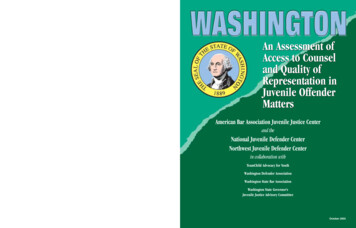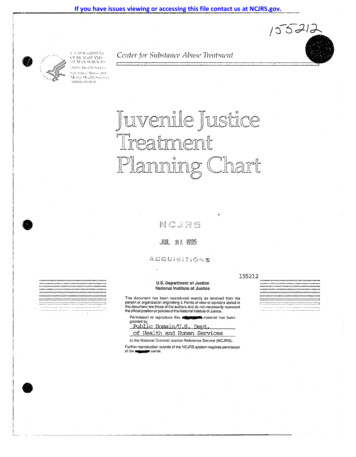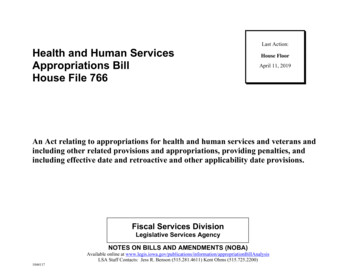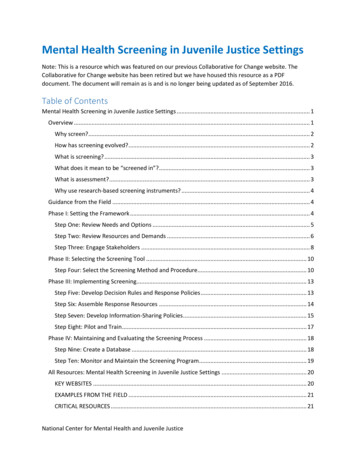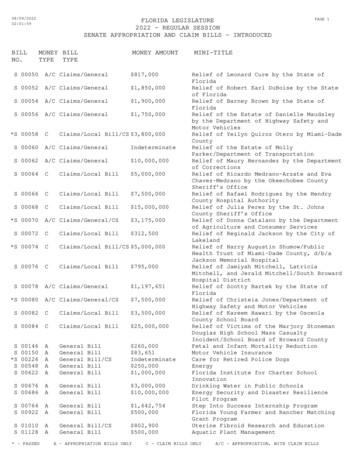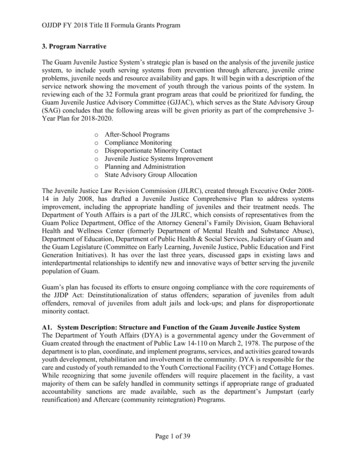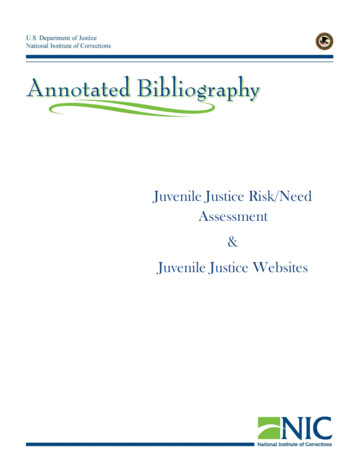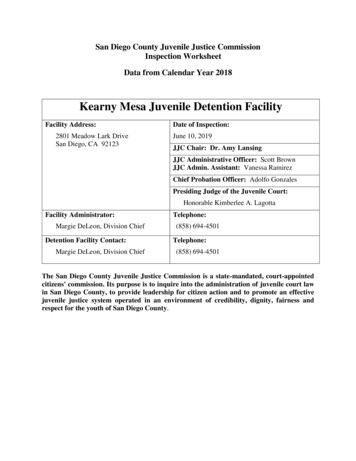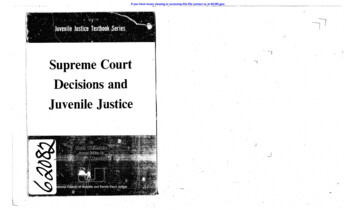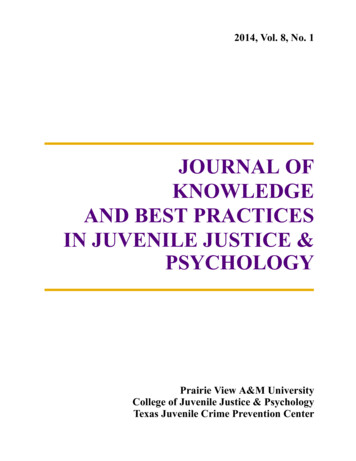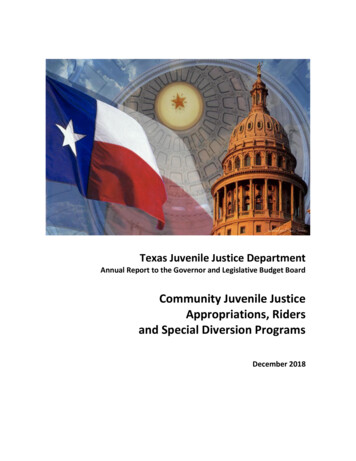
Transcription
Texas Juvenile Justice DepartmentAnnual Report to the Governor and Legislative Budget BoardCommunity Juvenile JusticeAppropriations, Ridersand Special Diversion ProgramsDecember 2018
BOARD MEMBERSThe Honorable Wes Ritchey, ChairDalhart, TexasEdeska Barnes, Jr.Jasper, TexasThe Honorable Carol BushWaxahachie, TexasJames CastroBergheim, TexasScott W. FisherBedford, TexasPama HencerlingVictoria, TexasThe Honorable Lisa K. JarrettSan Antonio, TexasDavid “Scott” MatthewGeorgetown, TexasMary Lou MendozaSan Antonio, TexasThe Honorable Stephanie MorenoBeeville, TexasCandy NobleLucas, TexasAllison PalmerSan Angelo, TexasJames SmithMidland, TexasThe Texas Juvenile Justice Department, anequal opportunity employer, does notdiscriminate on the basis of race, color,national origin, sex, religion, age or disabilityin employment or the provision of services,programs or activities. In compliance withthe Americans with Disabilities Act, thisdocument may be requested in alternativeformats by contacting the Texas JuvenileJustice Department.Annual Report to theGovernor and Legislative Budget BoardCOMMUNITY JUVENILE JUSTICEAPPROPRIATIONS, RIDERS ANDSPECIAL DIVERSION PROGRAMSTexas Juvenile Justice DepartmentCamille Cain, Executive Director11209 Metric Boulevard, Building H, Suite AP.O. Box 12757Austin, Texas 78711www.tjjd.texas.govProbation ServicesP (512) 490-7991 I F (512) 490-7717State ServicesP (512) 490-7128 I F (512) 490-7717Published December 2018
CERTIFICATEAgency Name: TEXAS JUVENILE JUSTICE DEPARTMENTThis is to certify that the information contained in this agency Annual Report filed with the Legislative BudgetBoard (LBB) and the Governor’s Statewide Budget and Policy Offices is accurate to the best of my knowledgeand that the electronic submission to the LBB and the bound paper copies are identical.
TABLE OF CONTENTSIntroduction . 6Description of Funding Contract and Allocation Methodology . 7Juvenile Justice System Effectiveness and Outcomes . 11Description of Training, Monitoring and Investigation . 26Financial Monitoring of County Grants. 29Appendix A: Annual Report to State Leadership . 32Appendix B: Definitions and Calculation Methodologies in the Juvenile Probation System . 34
This page intentionally left blank.
INTRODUCTIONThe Texas Juvenile Justice Department (TJJD) was created December 1, 2011, combining the functions of the TexasYouth Commission (TYC) and the Texas Juvenile Probation Commission (TJPC). The mission statement of the TJJD is:Transforming Young Lives and Creating Safer Communities.The core values of the Texas Juvenile Justice Department include: JUSTICE: We do the right thing, in all things, with all people. SAFETY: We commit to a culture that protects youth, employees, and the public. INTEGRITY: We build trust through transparency and ethical behavior. PARTNERSHIP: We achieve best results through collaboration with counties, stakeholders, youth and theirfamilies. INNOVATION: We proactively create opportunities to improve the juvenile justice system.The vision of the Texas Juvenile Justice Department is an effective and integrated juvenile justice system that: Advances public safety through rehabilitation. Equitably affords youth access to services matching their needs to enhance opportunities for a satisfying andproductive life. Employs a stabilized and engaged workforce fully empowered to be agents of change. Operates safe and therapeutic environments with positive peer cultures emphasizing mutual accountability. Is a model system with innovative, data-driven, and successful programming.This annual report is provided in compliance with Riders 26 and 27 of TJJD’s 2018-2019 appropriations bill pattern, andincludes the impact of initiatives such as residential placements, community-based programs and services for serious,chronic felons and for misdemeanor offenders no longer eligible for commitment to TJJD.6
DESCRIPTION OF FUNDING CONTRACT AND ALLOCATION METHODOLOGYFunding OverviewThe Texas Juvenile Justice Department (TJJD) allocates funds appropriated by the Texas Legislature through grants toassist local juvenile boards in operating juvenile probation departments, juvenile detention and correctional facilities,and to assist in providing basic and special services to children in the juvenile probation system. TJJD allocates thesefunds to local juvenile probation departments through the State Aid and Targeted Grant Contract that encompassesgrants to each of the 166 juvenile boards. The majority of the funding to the community-based juvenile probationsystem is provided by local county governments. In fiscal year 2018, county funding accounted for 74% of total juvenileprobation funding while state funding accounted for 25% and federal funding accounted for 1%.County and State Funding ComparisonFiscal Year 2018Federal 1,957,9601%State 146,560,30925%County 431,184,09074%Current and prior departmental funding disbursements by fiscal year and by county for all probation grants can befound online at hcontracts.aspx. Community-based programinformation by department and grant are located in the TJJD Program and Services Registry available online trategy A.1.1. Prevention and InterventionEstablished Fiscal Year 2012Total Amount Appropriated for Fiscal Year 2018: 3,012,177Description: In January 2012, the TJJD Board approved 1.4 million to fund prevention and early intervention services.In February 2012, the program announcement and submission guidelines related to prevention grants were distributedto all probation departments and twenty-three departments received funding. The target populations were defined aschildren, adolescents, and youth (ages 6 to 17) who are not currently under departmental supervision, but are atincreased risk of delinquency, truancy, dropping out of school, or referral to the juvenile justice system. The submissionguidelines indicated a preference for evidence/research-based or promising practices. In total, thirty-five countiesreceived thirty-seven grant awards during fiscal year 2018.Services are expected to be culturally competent and designed to successfully engage youth’s family. The minimumrequired data include school attendance and juvenile justice referrals for students participating in theprogram. Counties are encouraged to engage in other data collection and analysis as possible. An agreement with theTexas Education Agency allows TJJD to match data for youth whose parents have signed consent forms, enabling theagency to assess school attendance rates, discipline referral rates, and ultimately, graduation rates for youth whoparticipate in the funded prevention programs.7
Funding Allocation Methodology: Each of the ongoing grants was scored by a four-person panel when originallysubmitted, using a rank order, upon which funding recommendations were based. Five specific areas were evaluatedon each application (Target Population [2 items], Program Goal [3 items], Program Activities [4 items], and BudgetInformation [5 items]). Scoring in each area ranged from 0 to the 5. A zero was given if the applicant failed to addressthe area and the highest possible score was given if the area was exceptionally well-addressed. The budget informationsubmitted was scored on a 0 to 10 scale. Funded programs included activities or services designed to focus on families,school-based intervention, out-of-school time, mental health needs, and skills- or character-building activities for youth.Strategy A.1.2. Basic SupervisionEstablished Fiscal Year 1982Total Amount Appropriated for Fiscal Year 2018: 35,778,526Strategy A.1.3. Community ProgramsEstablished Fiscal Year 2014Total Amount Appropriated for Fiscal Year 2018: 44,900,650Strategy A.1.4. Pre & Post Adjudication FacilitiesTotal Amount Appropriated for Fiscal Year 2018: 24,782,157Strategy A.1.5. Commitment Diversion InitiativesTotal Amount Appropriated for Fiscal Year 2018: 19,492,500Strategy A.1.7. Mental Health ServicesEstablished Fiscal Year 2014Established Fiscal Year 2010Established Fiscal Year 2014Total Amount Appropriated for Fiscal Year 2018: 12,804,748State AidDescription: The State Aid grant is by far the largest source of state funds in support of local juvenile boards to: (1)provide basic juvenile probation programs and services that are effectively delivered and adhere to standards andpolicies; (2) divert youth from commitment to a state residential facility through new or expanded community-basedprograms; and (3) increase the availability of mental health services for juveniles referred to and under the supervisionof juvenile probation departments, including screenings, assessments/evaluations, programs, and placements. Theseobjectives are achieved through the five component grants of State Aid – Basic Probation Supervision, CommunityPrograms, Pre & Post Adjudication, Commitment Diversion, and Mental Health Services – which align with TJJD’sappropriations structure.Funding Allocation Methodology: The largest portion of departmental State Aid grant allocations were determined bya funding formula that accounts for each jurisdiction’s juvenile population and referrals, with adjustments made forprior year’s allocations. The majority of each department’s total was allocated across the five funding categories notedabove based on the department’s historical spending patterns. The remainder of the department’s allocation wasassigned to a “Flexible Funds” category that the department could budget under any category.There are two competitive grant programs provided within the State Aid grant. Discretionary State Aid (DSA) wascreated to comply with Human Resources Code (HRC) Section 223.001(c) and began in fiscal year 2017. DSA supportsprobation programs and services with a clearly defined target population that use research-driven practices and havewell-defined recidivism reduction goals. The focus of DSA is intensive, community-based programs and aftercare (notprevention-type programs or residential placement), with preference given to programs for moderate- to high-riskjuveniles with corresponding treatment needs. Additionally, funds can be distributed throughout the course of thefiscal year via the Supplemental and Emergent Needs (S&E) program. The S&E program responds to changing andunanticipated circumstances, principally in support of youth services to avoid increased commitments to TJJD.8
The structure and budgeting requirements of the current State Aid program are designed to ensure maximum fundingflexibility as well as adherence to TJJD’s budget structure and transfer limits as required by the agency’s Rider 30 in the2018-2019 General Appropriations Act. In fiscal year 2018, TJJD distributed a total of 131,884,665 through the StateAid program, including Discretionary State Aid awards. No Supplemental and Emergent Needs awards were given infiscal year 2018.Special Needs Diversionary Programs (Grant M)Established Fiscal Year 2002Total Amount Appropriated for Fiscal Year 2018: 1,895,175Description: The Special Needs Diversionary Program (SNDP) Grant is designed to increase the availability of effectiveservices to juvenile offenders with mental health needs. TJJD has worked in coordination with the Texas CorrectionalOffice on Offenders with Medical or Mental Impairments (TCOOMMI) and in cooperation with Mental Health Authority(MHA) agencies or other local mental health service providers, to implement programs that provide services to juvenilesunder the supervision of 20 local juvenile probation departments during fiscal year 2018.Funding Allocation Methodology: Consistent with historical awards, in fiscal year 2018, TJJD distributed funds in theamount of 1,895,175 for specialized probation officers to work with juvenile offenders with mental health needs.Juvenile probation departments that utilize these funds enter into a cooperative arrangement for services with theirlocal MHA agency or another local mental health service provider.Harris County Leadership Academy (Grant D)Established Fiscal Year 1996Total Amount Appropriated for Fiscal Year 2018: 1,000,000Description: The Harris County Leadership Academy provides a residential intensive cognitive-based program toredirect the thinking and behavior patterns of male juveniles and remove barriers to their successful transition back totheir families and communitiesFunding Allocation Methodology: As directed by rider, TJJD allocated 1,000,000 in available grant funds for operationof the Harris County Leadership Academy.Strategy A.1.8. Regional Diversion AlternativesEstablished Fiscal Year 2016Total Amount Appropriated for Fiscal Year 2018: 11,312,201Description: The Regional Diversion Alternatives program seeks to build capacity, regional collaboration, and access toprograms and services with the goal to treat more youth “closer to home,” and avoid youth commitment to stateresidential programs. TJJD began the planning process for this initiative immediately following the conclusion of the84th Legislative Session and included the collaborative work of a Regionalization Task Force. The task force involved theparticipation of probation practitioners, contract vendors, advocates, legislative stakeholders, judges and prosecutors.Planning concluded in May 2016 and TJJD began approving diversion applications in June. For fiscal year 2018, TJJDapproved 2,924,445 to support regional services enhancement projects and 7,512,756 to reimburse expenses forindividual youth diversions. As of October 18, 2018, the agency had disbursed 2,924,445 and 4,435,999 to juvenileprobation departments for regional projects and youth diversions, respectively.Funding Allocation Methodology: Funding under this program is awarded through an application process for“individual youth diversion plans.” A department identifies a youth meeting the target population, demonstrates prioreffort to treat the youth locally, and proposes additional programs and services within the region or a nearby regionthat would help the department avoid commitment to TJJD. Additionally, the department must certify that if not forthe regional diversion program the department’s recommendation would be for commitment. Once an individualdiversion plan is approved and its funding limit is set, the department begins providing the indicated services, andrequests reimbursement against the approved funding amount from TJJD.9
Apart from individual diversion plans each of the seven regions was also allocated up to 125,000 to initiate, expand,or otherwise improve programs and services in support of the goal of treating more troubled youth closer to their homecommunities.Strategy A.1.9. Probation System SupportEstablished Fiscal Year 2016Total Amount Appropriated for Fiscal Year 2018: 2,758,113Juvenile Justice Information SharingEstablished Fiscal Year 2010Description: The Juvenile Case Management System (JCMS) is a comprehensive, state-of-the-art, web-based juvenilejustice information and case management system providing common data collection, reporting and management forTexas juvenile probation departments. JCMS provides statewide data sharing between the 166 juvenile boards, theTexas Juvenile Justice Department, and the Department of Public Safety. The system consists of core case managementcomponents (intake, referral, case management, etc.) and additional enhancement features such as detention,institution management, law enforcement, and Juvenile Justice Alternative Education Programs (JJAEPs). JCMSfacilitates sharing of data between juvenile justice agencies both across and within jurisdictions to allow for betterfocused programs and services to be offered to juvenile offenders. Operational costs are shared between TJJD, Collin,Dallas, Denton, Johnson, and Tarrant counties.Funding Allocation Methodology: In fiscal year 2018, TJJD allocated 1,260,000 toward the continued maintenanceand operation costs of JCMS. Operation expenses include fees charged by the Managed Server Hosting provider tohost, operate and maintain the physical servers; storage and network components of JCMS for the Production,Development/Test and Conversion environments; as well as the dedicated support staff that comprise the JCMS supportinfrastructure. Maintenance-related expenses include the costs of correcting deficiencies in the existing programmingor functionality of the software application.10
JUVENILE JUSTICE SYSTEM EFFECTIVENESS AND OUTCOMESThe Texas Juvenile Justice Department (TJJD) disburses funds appropriated by the Texas Legislature to local juvenileprobation departments through the eight grants and three reimbursement programs encompassed in the State Aid andTargeted Grant Contract. These grants ensure that all juveniles have access to juvenile probation services throughoutthe state and provide supervision, programs, services and residential placements to juveniles under the jurisdiction ofthe 166 juvenile boards.TJJD grant funding is used at every point in the juvenile probation system. Because each grant and reimbursementprogram includes specific expenditure requirements and spending limits, departments blend funds to support the mostappropriate level of supervision or service for a juvenile. In fiscal year 2018, all juvenile probation departments receivedthe state aid grant, with some departments receiving as many as seven different state grants and reimbursementprograms.Juveniles under supervision include those on informal deferred prosecution supervision as well as those on formalcourt-ordered probation supervision. During their time under formal probation supervision, juveniles typically receivenumerous services and programs. In addition to the supervision provided by their probation officer, juveniles leavingformal probation supervision in fiscal year 2018 received the following programs and services during their time onprobation: 80% participated in at least one community-based program;82% had been detained at least once;34% had been in a residential placement at least once;81% had at least one drug test;68% received at least one behavioral health service; and20% received at least one non-residential service.As described above, each juvenile was provided supervision and services through numerous TJJD grants and localfunding. No one funding source and no one program or service determines a juvenile’s success or failure undersupervision. The combination of the supervision and services that a juvenile receives while under supervisiondetermines the impact juvenile probation has on that child’s successful rehabilitation.This section provides information on the supervision, programs, and services provided through local juvenile probationdepartments as well as a report on the effectiveness of the juvenile probation system.Measuring EffectivenessTJJD receives data from all juvenile probation departments through the monthly extract process (electronic datasubmission). Departments report individual level data on all juveniles referred, disposed, detained, placed in aresidential facility, and/or provided a program or service. Data reported must conform to TJJD Electronic DataInterchange (EDI) specifications. Because TJJD receives data on all juveniles served by juvenile probation departmentsstatewide, analysis and evaluation of the juvenile probation system is completed using all statewide data availablerather than relying on a sample of juveniles served. A copy of the TJJD EDI specifications can be found online etail.aspx.11
The efforts, effectiveness, and accountability of the juvenile probation system is evaluated by TJJD using the followingmeasures: Formal referrals to juvenile probation departments Commitments to TJJD Adult Certifications Average Daily Population (ADP) of juveniles on Deferred Prosecution and Probation Supervision Total juveniles served on Deferred Prosecution and Probation Supervision Supervision Outcomes for juveniles leaving Deferred Prosecution and Probation Supervision Number of juveniles beginning programs and/or residential placements Average Daily Population (ADP) of juveniles in secure and non-secure placements Re-referral and incarceration rates for juveniles under supervision or placed in a secure residential facilityDefinitions and calculation methodologies can be found in Appendix B.Juvenile Probation System OutcomesIn fiscal year 2018, there were 53,228 formal referrals to juvenile probation departments throughout the state of Texas.This represents a 1% decrease from the 53,860 formal referrals in fiscal year 2017. A little over half of these referrals(51%) were for class A and B misdemeanor offenses, while felony offenses accounted for 27% of referrals, violations ofprobation accounted for 15% and Conduct Indicating a Need for Supervision (CINS) offenses accounted for 7% ofreferrals.These 53,228 referrals came from 38,912 juveniles, 72% of whom were male. Almost half (49%) of all juveniles formallyreferred in the fiscal year were Hispanic, while 26% were African American and 24% were White. The average age ofjuveniles formally referred to the probation departments was 15-years-old. Of the 38,912 juveniles referred in fiscalyear 2018, a majority (79%) had only one referral, while 13% had two referrals and 8% had three or more referrals. Ofthe youth referred to juvenile probation departments in fiscal year 2018, 37% had identified mental health needs.In 77% of referrals in fiscal year 2018, the juvenile was attending school at the time they were referred. In another 12%of referrals, the juvenile was attending school in a Disciplinary Alternative Education Program (DAEP) or in a JuvenileJustice Alternative Education Program (JJAEP) at the time of their referral. At the time of intake, a formally referredjuvenile is assessed to determine if they have a need for substance abuse services. In 22% of the referrals in fiscal year2018, the juvenile had a known substance abuse problem; a need for substance abuse services was suspected in another10% of referrals.Juvenile probation departments, prosecutors, and juvenile courts disposed 55,185 cases in fiscal year 2018. Thisrepresents a 0.1% increase from the previous year’s 55,110 dispositions. A juvenile whose case is disposed may receivea supervisory caution, be placed on deferred prosecution supervision or probation supervision, be committed to TJJD,or be certified as an adult. Juveniles may also have their cases dismissed or dropped, transferred, or consolidated withanother court disposition.In fiscal year 2018, TJJD commitment dispositions accounted for 1.4% of total dispositions. Commitment dispositionsdecreased from 819 in fiscal year 2017 to 758 in fiscal year 2018, a 7% decrease. About 44% of all commitmentdispositions were for a violation of a felony probation court order, and an additional 37% of commitment dispositionswere for a violent felony offense. The remaining 19% of commitment dispositions were for a non-violent felony offense.Accounting for less than 1% of all disposition, 156 individuals were certified as adults in fiscal year 2018. This representsa 13% increase in certifications over fiscal year 2017. While all individuals certified committed the alleged offense whileunder the age of 17, not all cases were referred to juvenile court before the person turned age 18, which is the age atwhich the juvenile court loses jurisdiction. Seventy-five percent of all individuals certified as adults were age 17 oryounger at the time of the referral to juvenile court, while 25% were age 18 or older. The average age at certification12
was age 18. Because the juvenile court loses jurisdiction at age 18, the only mechanism to pursue a felony case referredafter the person has turned 18 is certification. If the case is ineligible for certification (i.e. not a felony), certification isnot sought, or certification is sought but not granted, the case is dismissed.Referrals and DispositionsFiscal Year 2017 and Fiscal Year 201820172018ChangeFormal Referrals to Juvenile Probation Departments53,86053,228-1%Juveniles Referred38,67738,912 0.6%Total Dispositions55,11055,185 0.1%Juveniles Committed to TJJD819758-7%Individuals Certified as an Adult138156 13%JUVENILES UNDER SUPERVISION IN THE COMMUNITYA juvenile referred to a probation department may be placed under supervision in the community through a deferredprosecution or court-ordered probation. In fiscal year 2018, 26,293 juveniles began a deferred prosecution or probationsupervision. During the year, 40,148 juveniles were served on deferred prosecution or probation supervision, adecrease of 0.3% from fiscal year 2017. Forty-one percent of the juveniles served on deferred prosecution or probationsupervision were referred for a felony offense, with 43% of those youth referred for a violent felony offense.Deferred prosecution is a voluntary supervision where the child, parent/guardian, prosecutor, and the juvenileprobation department agree upon conditions of supervision. If a juvenile violates the conditions of a deferredagreement, the department may elect to proceed with a formal court adjudication and begin a probation supervision.Deferred prosecution supervision can last up to six months, and juveniles are eligible to receive any services and/orprogramming a juvenile probation department offers while on supervision. Of the 13,959 juveniles who starteddeferred prosecution supervision in fiscal year 2018, 63% demonstrated a low risk of reoffending.Juveniles placed on adjudicated probation receive court-ordered supervision and must abide by the conditions ofsupervision stipulated in their court order. Juveniles are most often placed on probation supervision for a term of oneyear, but may be placed on probation supervision until their eighteenth birthday. In fiscal year 2018, 12,334 juvenilesbegan probation supervision. Twenty-four percent of these juveniles demonstrated a high risk of reoffending, andanother 34% displayed a medium risk of reoffending. Juveniles under probation supervision may be served on a regular,specialized, or intensive caseload. Specialized caseloads target juveniles with special needs by providing additionalsupervision, contacts and services. Examples of specialized caseloads include those for juveniles with mental healthissues, female offenders, gang members, sex offenders, and juveniles with substance abuse problems.Juveniles under Supervision in the CommunityFiscal Year 2017 and Fiscal Year 201820172018ChangeJuveniles starting Deferred Prosecution Supervision13,27713,959 5%Juveniles starting Probation Supervision12,78612,334-4%Total Juveniles starting Deferred or Probation Supervision26,06326,293 1%Total Juveniles served on Deferred or Probation Supervision40,28840,148-0.3%Average Daily Population of Juveniles on Deferred Prosecution Supervision5,6505,842 3%Average Daily Population of Juveniles on Probation Supervision11,42911,007-4%13
In fiscal year 2018, 23,157 juveniles ended their deferred prosecution or probation supervision. Possible outcomes ofa juvenile’s supervision include successful completion, termination due to failure to comply with the conditions ofsupervision, TJJD commitment as a result of a violation or new offense, or transfer to the adult system as the result ofa new offense not under the jurisdiction of the juvenile court. Eighty-two percent of juveniles ended their deferredprosecution supervision successfully, while 83% of juveniles ended their probation supervision successfully. Twopercent of all juveniles ending their supervision in the fiscal year were committed to TJJD.Juveniles Ending Deferred Prosecution and Probation SupervisionFiscal Year 2017 and Fiscal Year 2018Fiscal Year 2017SuccessfulFiscal Year 2018Not SuccessfulSuccessfulNot 19,31682%4,36318%19,04182%4,11618%JUVENILES PARTICIPATING IN COMMUNITY–BASED PROGRAMSIn order to keep delinquent juveniles closer to their home communities, juvenile probation departments have beencharged with the task of pairing juveniles with appropriate community-based resources and services, includingprogramming. In fiscal year 2018, juvenile probation departments offered 1,448 community-based programs tojuveniles under their jurisdiction, their families, and at-risk youth in the area. Many programs offered by juvenileprobation departments are designed to meet the needs of a wide array of youth. Of program participants in fiscal year2018, 39% participated in a skill-building/activity-based program, 34% participated in a treatment-based program, and27% participated in a surveillance-based program.Juvenile probation departments do not always wait until disposition to enroll a juvenile in needed programming. Acrossthe state, 713 programs allow juveniles who are awaiting disposition to participate. Of the juveniles enrolled in a predisposition program, 6,210 (55%) were under temporary pre-court monitoring or conditional pre-dispositionsupervision in fiscal year 2018. The most common pre-disposition programs juveniles participated in were an earlyintervention
Programs, Pre & Post Adjudication, Commitment Diversion, and Mental Health Services - which align with TJJD's . flexibility as well as adherence to TJJD's budget structure and transfer limits as required by the agency's Rider 30 in the 2018-2019 General Appropriations Act. In fiscal year 2018, TJJD distributed a total of 131,884,665 .
